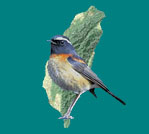 |
|
||||||||||||
|
|
|||||||||||||
 |
|
||||||||||||
|
|
|||||||||||||
|
Scheduled Tours
Trip Reports Trip Report: BIRDING IN TAIWAN, FEB.24-26, 2006 Trip Report: BIRDING IN TAIWAN, NOV.28-Dec.2, 2005 ANNOTATED SPECIES LIST, Taiwan, NOV.28-Dec.2, 2005 Trip Report: BIRDING IN TAIWAN, NOV. 7-16, 2005 ANNOTATED SPECIES LIST, Taiwan, NOV. 7-16, 2005 Trip Report: BIRDING IN TAIWAN, MAY. 2-11, 2005 ANNOTATED SPECIES LIST, Taiwan, MAY. 2-11, 2005 Trip Report: BIRDING IN TAIWAN, MAY. 21-24, 2005 ANNOTATED SPECIES LIST, Taiwan, MAY. 21-24, 2005 Trip Report: BIRDING IN TAIWAN, NOV. 8–17, 2004 ANNOTATED SPECIES LIST, Taiwan, NOV. 8–17, 2004 Taiwan Trip Report, March 21 – 28, 2003 ANNOTATED SPECIES LIST, Taiwan, March 21 – 28, 2003 Taiwan Trip Report, November 11-19, 2003 ANNOTATED SPECIES LIST, Taiwan, November 11–19, 2003
BirdingASIA -Birdwatching in Taiwan
|
(E) = Endemi Taiwan is a mountainous island in the South China Sea, about 160 km (100 miles) off the Chinese mainland. The forested beauty of the island led Portuguese sailors in 1590 to name it Ilha Formosa, meaning “Beautiful Island.” The tropic of Cancer passes through the southern part of the island.
The 5-day field trip followed the 2005 Waterbird Society conference, held in Tainan, Taiwan, Nov. 24–27. As there had been a field trip during the conference to see the wintering Black-faced Spoonbills at Chiku, the post-conference trip did not go there. This extended field trip, organized by Birding in Taiwan and the Taiwan International Birding Association, began with our departure from Tainan and concluded in Taipei.
Nov. 28: We began with a day of wetlands, with Wu Ten-Di as our chief bird guide. While Pheasant-tailed Jacana is not globally endangered, it is a very rare resident in Taiwan. So, after leaving Tainan in our bus in the morning, we visited the Pheasant-tailed Jacana Restoration Zone at Kwantien, in Tainan County, which illustrates a conservation and co-operation success story. It was constructed in 2002 by the combined efforts of the Wild Bird Federation of Taiwan and many volunteers, to replace the jacanas’ original habitat in Taiwan, a natural wetland at Hulupi, which was to be destroyed to make way for a high-speed train project. In due course, when the Hulupi wetland was drained, the jacanas found and accepted the new 15-hectare replacement site at Kwantien, 2 km away, and appear to be thriving there. The Kwantien Pheasant-tailed Jacana Restoration Zone property is rented from the land-owner, the Taiwan Sugar Company; the rent is paid by the high-speed rail consortium. Also noted at the Kwantien site were Greater Painted-Snipe, Eurasian Coot, Nutmeg Munia, Wood Sandpiper, Common Snipe, Oriental Skylark, Zitting Cisticola and many Light-vented Bulbul, which was one of the most common species on the trip. From Kwantien, we went to Aougu and then to Hambao for more shorebirding. In one of the fallow fields at Hambao, we found a rare Oriental Plover, only100m from where another had been seen in May. Other species for the day included Little Grebe, Great Cormorant, Gray and Purple Herons; Great, Little and Cattle Egrets; Black-crowned Night-Heron, Yellow Bittern, Sacred Ibis (introduced), Spot-billed Duck, Eastern Marsh-Harrier, Eurasian Kestrel, Black-winged Stilt, Pacific Golden-Plover, Black-bellied, Little Ringed, and Snowy Plovers; Eurasian Curlew, Common Redshank, Common Greenshank; Wood, Terek, Curlew and Common Sandpipers; Saunders’ Gull, Caspian Tern, Long-tailed Shrike (singing), Siberian Stonechat, and Crested Myna. We continued the short distance to historic Lugang for the night. We said good-bye to Ten-Di, as he would not be able to be with after this day.
In the afternoon, we drove inland to Huisun Forest Station, elevation 770m (2350 ft.) With a few hours of daylight remaining, we found Daurian Redstart on the road, then climbed the180 wooden steps opposite the office to the gravelled service road to look for birds of mid-elevation forest. We found Gray Treepie, Large-billed Crow, Vivid Niltava, Black-browed Barbet, Gray-capped Woodpecker, and the first endemic species, WHITE-EARED SIBIA (E). Dusk is a prime time to encounter Swinhoe’s Pheasants also, but we weren’t lucky. After supper, some of us tried owling, but no owls were heard. Night at the Atayal Resort, Huisun Forest Station.
Nov. 30: Our designated assembly time was
6 a.m, but some of the group were out at
5:00,
After leaving Aowanda NFRA, we drove higher, to Chingjing, elev. 1750m (5740 ft.); night at Chingjing Resort.
Dec. 1: After a very early “birders’ breakfast”, we
boarded our bus for the short
Dec. 2: Before leaving our hotel, Vinous-throated Parrotbill, Siberian Rubythroat and Steere’s Liocichla (E) were seen in the vegetation on the hillside. Repeating our short drive of yesterday, we had 2 early morning hours—our last hours in the field—on Blue Gate Trail #1. Again, we split into small parties for a final chance for SWINHOE’S PHEASANT (E); success for most of the group. Others only heard a bird running away through the dried leaves on the forest floor. Additional species of the morning included Pygmy Wren-Babbler, COLLARED BUSH-ROBIN (E), Strong-footed Bush-Warbler, and an unidentifiable needletail. It was time to make the long drive to Taipei, arriving in mid-afternoon. There was some shopping time at the Chinese Handcraft Mart, followed by a Taiwanese foot massage for some while others explored a little of a night market. It was a stimulating end to a successful 5-day field trip.
In total, 136 bird species were observed, plus the needletail which could not be fully identified.
|